Where Corn and Soybeans are King, Some Farmers See ‘Unconventional’ Future
In Iowa, the pandemic and subsequent higher food prices have boosted interest in farming differently. But while interest is growing, unconventional farming isn’t always easy.
Where Corn and Soybeans are King, Some Farmers See ‘Unconventional’ Future
In Iowa, the pandemic and subsequent higher food prices have boosted interest in farming differently. But while interest is growing, unconventional farming isn’t always easy.
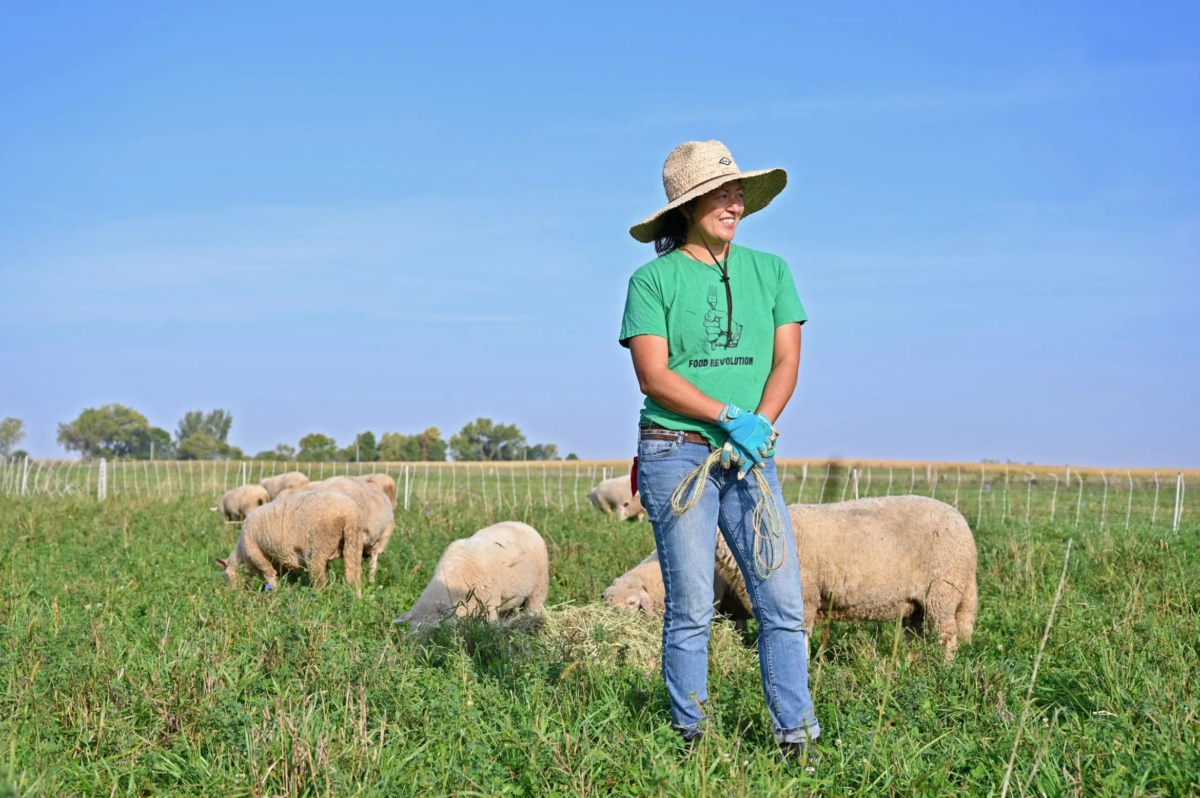
Wendy Johnson farms near Charles City, Iowa. She and her husband grow crops and raise sheep and lamb on their 130-acre farm.courtesy of Wendy Johnson via Investigate Midwest
This story was originally published on Investigate Midwest.
Corn and soybeans dominate the Hawkeye State’s rural landscapes.
In 2022, Iowa farmers harvested 12.4 million acres of corn and 10 million acres of soybeans, according to the USDA National Agricultural Statistics Service Information.
And in the Midwest, 127 million acres of land overall are dedicated to ag, said the USDA.
Popping up between those tall stalks of corn and velvety leaves of soybeans are other plants. Of the Midwest’s overall acres, 75 percent are covered by corn and soybeans. The other quarter produces crops from alfalfa and apples to watermelon and wheat.
In Iowa, unconventional farming—growing crops aside from industrial grain—ranges from soybeans grown and made into tofu near Iowa City to an environmentally-minded O’Brien County farmer who went organic decades ago. The pandemic and subsequent higher food prices have boosted interest in farming differently, several ag experts said. And while interest is growing, unconventional farming isn’t always easy.
“You saw people coming back, to buy land and buy houses, and wanting to live in more rural communities and have that quality of life and sense of connection and sense of community,” said Giselle Bruskewitz of Iowa Valley Resource Conservation & Development. The organization works with growers and food hubs in eastern and central Iowa counties.
That trend prompted some Iowans to look at stores and resources closer to home—to local growers, local meat lockers, local dairies and even local greenhouses. The upshot has been a boost to local economies.
But the prominence of conventional farming—corn, soybeans and associated subsidies—makes it an easier path for many farmers to pursue, said Sarah Carlson, senior programs and member engagement director with Practical Farmers of Iowa, an organization focused on building resilient farms and communities.
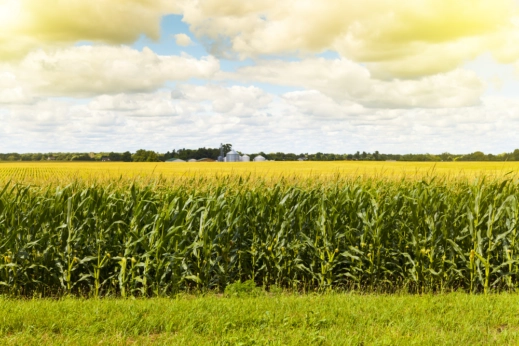
For farmers pursuing other crops or products, challenges include a lack of financial support and making inroads in the greater marketplace
“The current system is so taken care of that it is, I think, hard for farmers who want to do anything that’s not corn and soybeans, and not commodity hogs, to do something different. And if they want to do something different, they shoulder all the risk of doing it,” she said.
Requests to lawmakers for comment were not returned.
Unconventional farming has the potential to contribute positively to local economies, experts said.
A 2016 study by the Union of Concerned Scientists, a nonprofit advocacy group of citizens and scientists, shows the potential for the number of jobs that could be created, and medium-sized farms supported, if grocery and convenience stores and institutions like schools and nursing homes bought more fresh food from local sources. The union has not updated its research since.
Extrapolating from surveys done by researchers with the Leopold Center for Sustainable Agriculture at Iowa State University, the UCS study projected that if just 25 percent of potential buyers purchased fresh food products from medium-sized farms, it would have an $800 million impact on Iowa’s economy, supporting more than 4,200 mid-sized farms and more than 88,000 agriculture jobs.
The UCS study further suggested that small to mid-sized farms—of about 50 to 1,000 acres according to the U.S. Department of Agriculture—have a more positive impact on rural communities, because they tend to buy feed, equipment and other farm inputs from local sources.
The UCS study forecasted that trend. Chuck Tryon said he sees it as president of Bushel Boy Produce, a Minnesota- and Iowa-based regional produce grower.
A tomato that ripens on the vine in a field or local greenhouse is of higher quality than one that ripens while sitting in the back of a truck being shipped across the country, Tryon said. Bushel Boy grows fresh vegetables and fruits in acres of greenhouses in Owatonna, Minnesota, and Mason City, Iowa, for sale in several upper Midwestern grocery chains.
The greenhouses use hydroponic technology—using water and no soil to cultivate plants—and the recycling of water throughout its facilities, including capturing rainwater and snow melt.
That kind of produce, producers and local ag experts say, also creates local jobs and contributes to the livelihood of communities closer to the homes of those who eat it.
It also creates a market that allows smaller farms and growers to become economically viable, Bruskewitz said.
Several grower associations did not respond to messages requesting comment.
Most corn and soybean farmers rely on subsidies, payments and other support from the government. Subsidies can support particular crops, conservation and more. Farmers outside of corn and soybeans, though, say they rarely have such support.
Organizations like Practical Farmers of Iowa (PFI) do offer some assistance. PFI has 5,000 members in Iowa and 41 other states. It started in 1985 amid the Farm Crisis.
“This alternative food system is going to have to be subsidized a lot by labor and the people just being so committed to the cause until it can stand on its own,” said Carlson of PFI.
Experts in sustainability and environment pointed out the irony that Iowa is a major producer of beef, dairy, eggs and pork, yet sends much of the products out of state.
“(PFI members’) farms are having a positive impact in the local community. They’re buying and interacting with businesses, to fix something, or to bank locally. We know it can be done—farms that have diversified (crops), soil has improved, less fossil fuel used, less fertilizer used. They yield very high,” Carlson said.
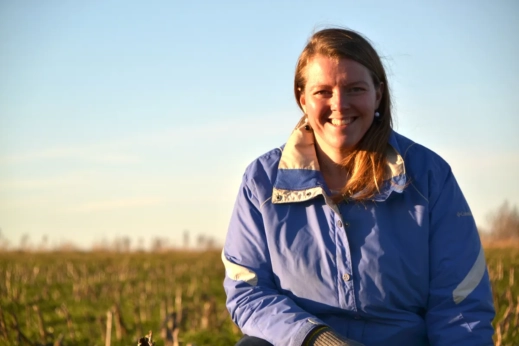
The state of Iowa attempted to rev up institutional buyers’ interest in locally produced food and food hubs, which connect producers with institutional buyers, through a grant program in August 2020. Called the Local Produce and Protein (LPP) Program, the one-year program was offered by the Iowa Department of Agriculture and Land Stewardship. It aimed to connect school districts with locally produced food.
A program report prepared by Iowa State University researchers, on behalf of the Iowa Food Hub Managers Working Group, showed 53 school districts participated in the LPP program. In 25 of those 53 participating areas, districts purchased local food through a food hub. Under the grant program, the state reimbursed school districts for the local food purchased.
The study noted, however, that 28 districts were unable to fulfill the grant and purchase food locally. They cited difficulty finding local food products or arranging delivery, and school staffing problems due to the pandemic.
“Schools that worked with a food hub were able to avoid the challenges of locating product and delivery, because those are tasks food hubs fulfill,” ISU researchers noted in the LPP report.
Food hubs help make local food production possible, experts said.
“The food hubs are building the infrastructure, connecting the dots of how do we store, how do we transport, how do we grow the markets for local producers and expanding access,” Bruskewitz said.
Prior to coming to Iowa Valley RC&D in July 2021, Bruskewitz helped launch and managed the Field to Family Food Hub in Iowa City.
“Connecting the dots,” Bruskewitz said, means building relationships between producers and consumers.
“How do you build the connections between those producers and those consumers and community members? It’s all about relationships,” she said. “That’s the heart of the culture here in Iowa and of these rural communities—just this idea that people care about each other.”
The infrastructure, she said, includes having warehousing, refrigerated trucks, and, as did some food hubs, offer online ordering.
“Just (having) those business efficiencies, which are really challenging when you’re a small producer,” Bruskewitz said. “Producers wear so many hats. They’re being asked to be so many things, all at the same time—and for little to no money a lot of the time. A lot of the vision is, how do we get producers a fair price, how do we help produce more food for the state, but also do that in a way that actually helps the producer.”
Beyond the economics, those growing, producing and distributing locally grown food believe in what they’re doing, Bruskewitz said.
“At least in the local-food community, I see a lot of young and passionate people, myself included, where I’ve decided to build a life and a career here,” she said. “I feel a real sense of community in the food system, and a sense of purpose and a sense of belonging. I think that’s ultimately what people really want.”
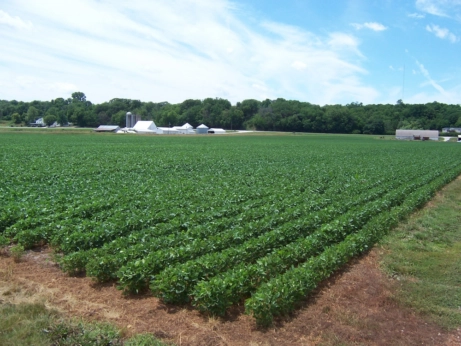
Bushel Boy in Mason City and Owatonna, Minnesota, has taken the concept of local food a big step beyond food hubs.
“Minnesota and Iowa is such a great food and agricultural ecosystem. Frankly, it’s one of the most vibrant food and ag ecosystems in the world. It has this incredible diversity,” said Tryon, company president. “Obviously, the big row crops are a driver: the processing facilities for sweet corn, peas, green beans. You have this balance of grains to special vegetables. And now, because of technology that can be brought into this world of indoor farming, you have fresh produce that can be grown 12 months out of the year.”
The best evidence of being local and scaling up was a semitrailer from Iowa-headquartered regional grocer Hy-Vee pulled up to the loading dock.
Bushel Boy’s Mason City operation has 17 acres of greenhouses growing different kinds of tomatoes. The Owatonna facility was growing strawberries at the time Investigate Midwest talked to Tryon.
“It’s a way to bring that fresh produce much closer to where the stores are,” said Tryon.
He knows the importance, having grown up in the food and grocery business; he’s the son of an Indiana grocer and cooks for himself.
“That produce right now is, in most cases coming from Mexico, California, in some cases Canada—Canada has a vibrant greenhouse infrastructure for some commodities,” Tryon said.
“I get asked if I think indoor farming is the future of agriculture. And my answer is no; it’s not the future. It’s one of the futures,” Tryon said.
Expanding to Iowa allowed Bushel Boy to nudge its geographic market to include Iowa, Minnesota and contiguous states and metro areas like St. Louis and Kansas City, Missouri, and Omaha, Nebraska, roughly matching some of its upper Midwest grocery chain customers, and deepening its market penetration.
“You start reaching some additional markets with good population bases, where we think this idea of ‘highest quality, locally grown, available year-round’ will mean something,” Tryon said.
In 2018, Bushel Boy was acquired by privately held malting producer Rahr Corp. of Shakopee, Minnesota, in a diversification move and expanded incrementally into new facilities and products. The brand is recognized regionally, and products are labeled as having been grown in Minnesota and Iowa.
Bushel Boy earned about $16 million in 2022, according to industry publications, with earnings growing with the expansion of products and facilities.
There are smaller examples of unconventional farming as well.
In 1998, James Nisly of Kalona, Iowa, in Washington County southwest of Iowa City, started Organic Greens, LLC. The company grows microgreens for sale to local restaurants and set up a food distribution network with local farmers, including those in the nearby Amish community.
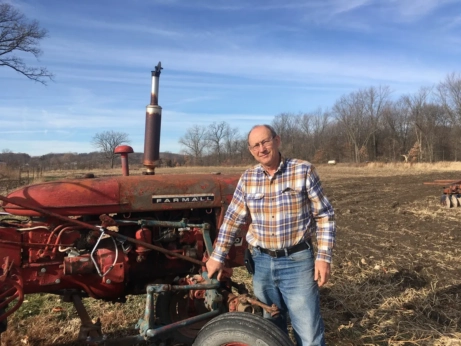
“I grew up in rural Kalona on a rural hobby farm,” said Nisly, one of seven children. “We had a big garden and a few cows and horses, goats, ducks and sheep. We did a lot of our own canning, garden crops. So I’m kind of familiar with what might be called the homesteading lifestyle, I suppose.”
He returned to Iowa after several years of working in Hawaii at a church that focused on healthy eating and natural food production. Besides microgreens, Nisly sells specialty sandwich and salad greens in grocery stores and to food service. He describes it as “indoor vertical farming.”
The idea that healthy food is the underpinnings of a healthy society is a timely concept, Nisly said.
“I just think it’s a reality that’s smacking America in the face right now,” he said.
Near Charles City, Wendy Johnson farms and is a board member of Ames-based PFI.
She and her husband have crops and livestock—sheep and lamb—on their 130-acre farm and see a noticeable difference in the variety of plants and animals on their land compared with nearby conventionally farmed acres.
In 2020, Johnson also started another business, Counting Sheep Sleep Co., that uses the wool from her sheep for sleeping products.
Johnson said incentives like the state LPP program grants are a start, but schools, hospitals and other organizations will need sustained support to purchase local food rather than school-meal-program support for purchases from large commercial food service vendors.
“It needs to be a fair playing field,” she said. “There are local producers that could probably provide volume, but they need the ‘in’ first and they need to have the time to get to that volume. There has to be more effort on the institutional side to warrant the growth of these farms.”
Johnson said their farming style may not make financial sense when compared to tilling up the perennials and planting corn and soybeans.
“Corn and soybeans are highly subsidized. It’s why farmers continue to farm that way,” she said. “That’s where, I think, the trouble lies looking into the future of unconventional ag. We need some help from the top down.”
***
Investigate Midwest is an independent, nonprofit newsroom. Our mission is to serve the public interest by exposing dangerous and costly practices of influential agricultural corporations and institutions through in-depth and data-driven investigative journalism.Visit us online at www.investigatemidwest.org.
This story was reported from the summer of 2022 through spring 2023 with support from the University of Northern Iowa’s Center for Energy and Environmental Education.
Follow us
This work is licensed under a Creative Commons Attribution-NoDerivatives 4.0 International License.
Want to republish a Modern Farmer story?
We are happy for Modern Farmer stories to be shared, and encourage you to republish our articles for your audience. When doing so, we ask that you follow these guidelines:
Please credit us and our writers
For the author byline, please use “Author Name, Modern Farmer.” At the top of our stories, if on the web, please include this text and link: “This story was originally published by Modern Farmer.”
Please make sure to include a link back to either our home page or the article URL.
At the bottom of the story, please include the following text:
“Modern Farmer is a nonprofit initiative dedicated to raising awareness and catalyzing action at the intersection of food, agriculture, and society. Read more at <link>Modern Farmer</link>.”
Use our widget
We’d like to be able to track our stories, so we ask that if you republish our content, you do so using our widget (located on the left hand side of the article). The HTML code has a built-in tracker that tells us the data and domain where the story was published, as well as view counts.
Check the image requirements
It’s your responsibility to confirm you're licensed to republish images in our articles. Some images, such as those from commercial providers, don't allow their images to be republished without permission or payment. Copyright terms are generally listed in the image caption and attribution. You are welcome to omit our images or substitute with your own. Charts and interactive graphics follow the same rules.
Don’t change too much. Or, ask us first.
Articles must be republished in their entirety. It’s okay to change references to time (“today” to “yesterday”) or location (“Iowa City, IA” to “here”). But please keep everything else the same.
If you feel strongly that a more material edit needs to be made, get in touch with us at [email protected]. We’re happy to discuss it with the original author, but we must have prior approval for changes before publication.
Special cases
Extracts. You may run the first few lines or paragraphs of the article and then say: “Read the full article at Modern Farmer” with a link back to the original article.
Quotes. You may quote authors provided you include a link back to the article URL.
Translations. These require writer approval. To inquire about translation of a Modern Farmer article, contact us at [email protected]
Signed consent / copyright release forms. These are not required, provided you are following these guidelines.
Print. Articles can be republished in print under these same rules, with the exception that you do not need to include the links.
Tag us
When sharing the story on social media, please tag us using the following: - Twitter (@ModFarm) - Facebook (@ModernFarmerMedia) - Instagram (@modfarm)
Use our content respectfully
Modern Farmer is a nonprofit and as such we share our content for free and in good faith in order to reach new audiences. Respectfully,
No selling ads against our stories. It’s okay to put our stories on pages with ads.
Don’t republish our material wholesale, or automatically; you need to select stories to be republished individually.
You have no rights to sell, license, syndicate, or otherwise represent yourself as the authorized owner of our material to any third parties. This means that you cannot actively publish or submit our work for syndication to third party platforms or apps like Apple News or Google News. We understand that publishers cannot fully control when certain third parties automatically summarize or crawl content from publishers’ own sites.
Keep in touch
We want to hear from you if you love Modern Farmer content, have a collaboration idea, or anything else to share. As a nonprofit outlet, we work in service of our community and are always open to comments, feedback, and ideas. Contact us at [email protected].by Pat Kinney, Investigate Midwest, Modern Farmer
November 3, 2023
Modern Farmer Weekly
Solutions Hub
Innovations, ideas and inspiration. Actionable solutions for a resilient food system.
ExploreExplore other topics
Share With Us
We want to hear from Modern Farmer readers who have thoughtful commentary, actionable solutions, or helpful ideas to share.
SubmitNecessary cookies are absolutely essential for the website to function properly. This category only includes cookies that ensures basic functionalities and security features of the website. These cookies do not store any personal information.
Any cookies that may not be particularly necessary for the website to function and are used specifically to collect user personal data via analytics, ads, other embedded contents are termed as non-necessary cookies.
The Iowa Local Produce and Protein (LPP) Program seems like a good idea, but only offering it for one year is just another example of the state merely paying lip service to anything not ‘big Ag.’ Clearly it would take at least a couple of years for interested farmers to recognize the existence of the program and then grow products for that market. Especially if tree fruits and nuts are to be included. Another issue not mentioned in the article is the risk of herbicide drift destroying a ‘non conventional’ crop. With dicamba drift becoming more prevalent every year, it… Read more »